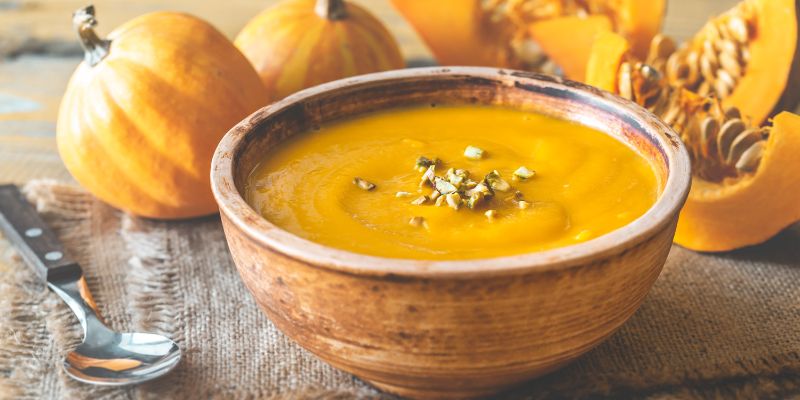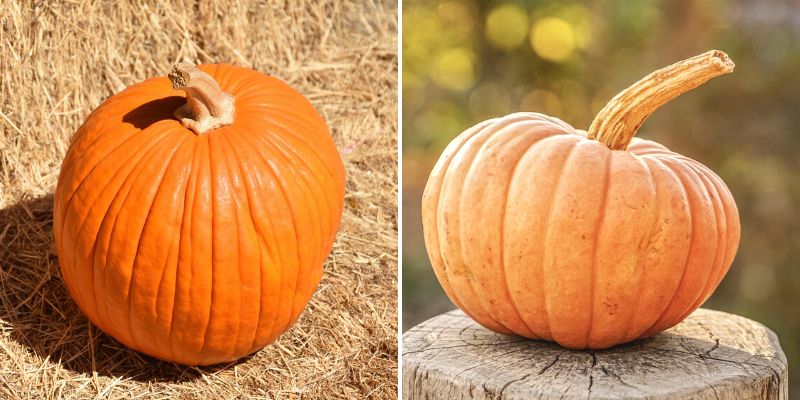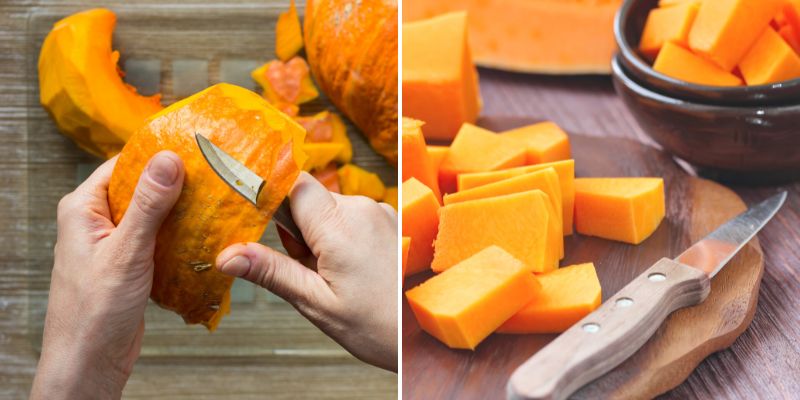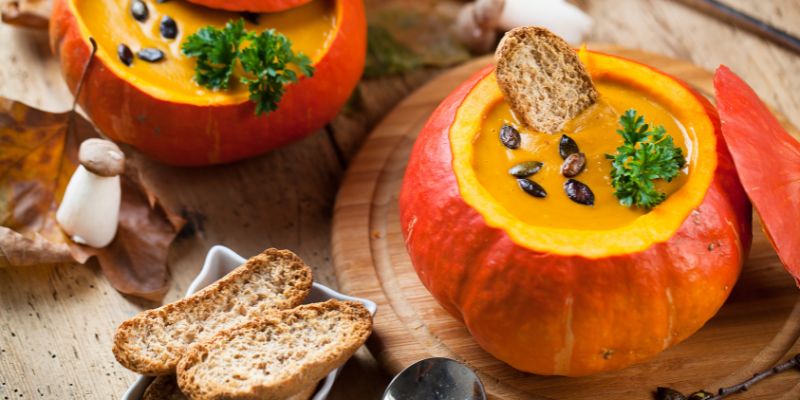When autumn settles in gently in the garden, before the first frosts appear, it's high time to harvest your beautiful pumpkins. Delicious as a purée or gratin, this orange squash is best enjoyed in a delicious homemade soup. But how to prepare your pumpkin? Which spices pair well with it? Discover our simple pumpkin soup recipe and tips to elevate it.

Pumpkin and squash, what's the difference?
- Although they belong to the same Cucurbitaceae family and originate from South America, pumpkin and squash are nevertheless two different varieties: the species Cucurbita pepo for pumpkin, like patty pans, courgettes or spaghetti squash, and the species Curcubita maxima for squash and kabocha squash.
- The shape also differs: the pumpkin has a round shape, orange in colour, which is why it's mainly used to make the famous Halloween pumpkin. The squash has a more ovate, even flattened shape and its colour ranges from orange to dark green.
- The flavour also differs: the pumpkin flesh is stringy, while squash flesh is sweeter and more tender.
- The peduncle on a pumpkin is hard and has 5 angular facets, whereas the squash peduncle is spongy, soft and has a cork-like appearance.

On the left a pumpkin, on the right a squash
When and how to harvest pumpkin
Pumpkin is generally harvested in October, before the first frosts, or even until mid-March if grown in a greenhouse. Pick the pumpkin when its peduncle becomes dry and woody. Using clean secateurs, cut the stem 3 or 4 cm above the squash, without removing this small piece of peduncle. Remove any traces of soil. The pumpkin can be stored all winter, indoors or in a cool room.
Which part of the pumpkin is edible?
In the pumpkin, everything is edible except the stem. The pumpkin flesh is mainly used to prepare soup, velouté, purée or gratin. The pumpkin skin can also be eaten, but it will be more or less tasty and tough depending on the variety. Generally, the smaller the pumpkin variety, the more tender its skin, like the 'Jack Be Little' squash. You can also use the skins to make crisps, cheese croutons or a pumpkin bark velouté. The pumpkin seeds can be roasted to enjoy as an appetiser, in salads or in a bowl of muesli.
The pumpkin soup recipe
Ingredients:
- 1 pumpkin ;
- 2 to 3 potatoes;
- 20 cl water;
- 20 cl milk;
- 1 heaped tablespoon of crème fraîche;
- 20 gr butter;
- 1 tablespoon sugar;
- 1 pinch of salt;
- Facultative: 1 teaspoon nutmeg and pepper.
Cooking time:
35 minutes
Recipe:
- 1/ Peel your pumpkin if you don't like its skin, then cut it in half with a knife.
- 2/ Using a tablespoon, remove the seeds.
- 3/ Then cut the pumpkin flesh into cubes.

Peel then cut the pumpkin into cubes
- 4/ Peel the potatoes, then also cut them into cubes.
- 5/ Melt a walnut-sized piece of butter in a large saucepan, pot or stockpot, then sauté your pumpkin and potato cubes for a few minutes.
- 6/ Add the glass of water, milk, sugar and facultatively the spices you want: nutmeg, pepper, etc.
- 7/ Cook for 30 minutes over medium heat.
- 8/ Blend everything, then add a spoonful of crème fraîche and adjust seasoning if needed.
My tips:
- You can replace cow's milk with coconut milk. In this case, I add a few carrots to my soup and a teaspoon of curry powder. Delicious!
- If you replace the pumpkin with sweeter-fleshed squash, there's no need to add powdered sugar. You can also replace sugar with honey.
- You can keep the pips to make another recipe: roasted pumpkin seeds.
- Small pumpkin varieties, like the 'Jack Be Little' squash, can serve as bowls to present your soup after being hollowed out.

Which spice pairs well with pumpkin?
Generally, it's warm spices that will pair best with this autumnal soup: nutmeg, cinnamon, ginger, chilli, but also curry. You can also add some aromatic herbs, like parsley, chives, tarragon or chervil.
What are the benefits of pumpkin?
Pumpkin and its seeds are said to have diuretic, depurative and anti-inflammatory properties. In the 19th century, it was also used as a vermifuge. Pumpkin is said to be rich in vitamin A, phosphorus and beta-carotin.
To go further:
- Discover all our varieties of squash.

































![[plant_guide id="1234" title="Pumpkin Soup Recipe" difficulty="easy"]
Ingredients:
- 1 {glossary}pumpkin{/glossary}, peeled and diced
- 1 onion, chopped
- 2 cloves of garlic, minced
- 1 litre of vegetable stock
- 1 teaspoon of {glossary}ground cinnamon{/glossary}
- Salt and pepper to taste
- Olive oil
Instructions:
1. In a large pot, heat some olive oil over medium heat.
2. Add the chopped onion and minced garlic, and cook until softened.
3. Add the diced pumpkin and vegetable stock to the pot.
4. Bring to a boil, then reduce heat and let it simmer for about 20 minutes or until the pumpkin is tender.
5. Using a blender, puree the soup until smooth.
6. Season with ground cinnamon, salt, and pepper.
7. Serve hot and enjoy!
This pumpkin soup recipe is perfect for a cosy autumn evening. It's simple to make and full of flavour. Give it a try and let us know what you think! pumpkin squash soup](https://en.promessedefleurs.eu/blogwp/wp-content/uploads/2022/12/Comment-preparer-une-soupe-a-la-citrouille-.png)
Comments